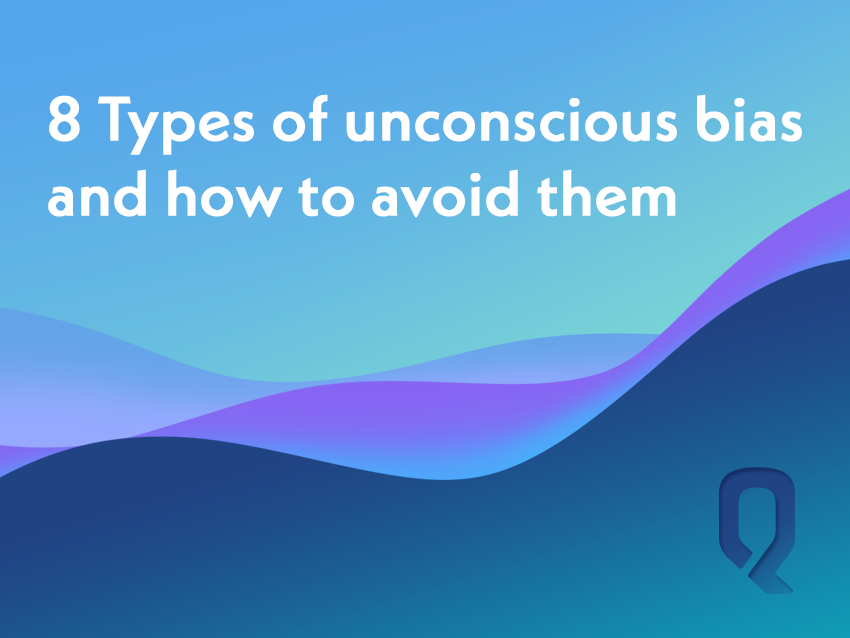
Unconscious bias part 3: 8 types of unconscious bias and how to avoid them
So far in this series, we’ve talked about what unconscious bias is and why it’s important to educate yourself about it, especially if you want to work with Diversity & Inclusion. Today, we’re diving into a few of the most common types of biases and how you can avoid them.
- Distance bias
All companies that have remote workers, whether full-time or as a hybrid model, suffer from distance bias. This is when ‘out of sight’ truly means ‘out of mind’, as we tend to prefer people or things that are closer to us in space and time. For instance, studies show that people are more likely to get promoted if they work together in person.
How to avoid distance bias:
When you have team meetings, use a video conference software like Zoom or Microsoft Teams so that everyone gets a virtual seat at the table, and make sure to invite virtual team members into the discussion. And if you’re a manager with remote team members, you should work remotely on a regular basis to keep things equal.
- Age bias
Age discrimination tends to favour younger employees, and it’s based on the belief that older employees are less capable of doing a job than their younger peers. This stems from an idea that your age affects your work abilities, knowledge, or skills. Although ageism affects everyone, women and minority groups are more affected as they already face multiple biases.
How to avoid age bias:
Management can combat ageism by including a variety of younger and older employees in a group, where they can interact and form positive relationships. This way, the younger employees will be able to observe and learn from the experience and know-how of their older peers.
- Conformity bias
Conformity bias is essentially peer pressure in the workplace, as the opinions of a group can have an impact on the opinions of an individual. This bias is most common in meetings and other team gatherings, where some team members might influence others in a way that affects the actions or behaviour of the entire group.
How to avoid conformity bias:
The best way to combat conformity bias is by utilising various group meeting techniques. There are many methods you can use, like allowing people to share their opinions anonymously, perhaps in writing or with a software.
- Affinity bias
Affinity bias is when people are naturally drawn to people who are similar to themselves, which can be based on aspects like age, ethnicity, gender, and more. This bias is very common during recruitment and interviews, and it will lead to a less diverse workplace if you let it influence which candidates you hire.
How to avoid affinity bias:
This kind of bias can be avoided by making sure that your workplace is a diverse environment to start with. Companies should actively aim to hire diverse staff to promote diversity, which starts during the recruitment process.
- Confirmation bias
Confirmation bias happens when a person consciously or subconsciously wants to confirm ideas or opinions they have, even when it means ignoring the truth. This behaviour is very common and can have a negative impact on your decision-making skills. For instance, if your company has done well by using certain strategies in the past, you might ignore the fact that you need to adjust them in order for the business to survive and thrive in the future.
How to avoid confirmation bias:
Avoid confirmation bias by educating yourself and building awareness of this bias, and by recognising that you should keep an open mind to new and different ideas. It helps to sometimes play ‘devil’s advocate’ by curiously investigating different perspectives and ways of thinking.
- Gender bias
Gender bias is when one sex is treated better than the other, for example when it comes to getting hired, promoted, or receiving job perks. This mostly affects women, who are treated less favourably despite having the same competence and capabilities as their male peers.
How to avoid gender bias:
One way to combat gender bias is to decide if a gender swap would matter in a specific job role. If employees are being considered for a promotion, you should consider whether it would make a difference if a man or woman was hired for the position and adjust accordingly.
- Attribution bias
Attribution bias is when you evaluate someone else’s behaviour based on their actions. For instance, you might assume that an employee is being lazy or disinterested if they’re often late to work. This bias can be toxic in the workplace, as it lets peers belittle one another by downplaying accomplishments and inflating mistakes, only viewing each other through a negative lens.
How to avoid attribution bias:
You can avoid attribution bias by being aware of it and maintaining a neutral approach. So if an employee or prospect are late to work, ask them why instead of making assumptions. Also, during work reviews and feedback, try to keep a neutral approach to age, gender, and ethnicity.
- Name bias
Name bias is when you prejudge someone solely based on their name, as it can hint to things like ethnicity or gender. So if an employer sees the names Tyler Smith and Alejandro Rodríguez in the CV pile, they might be more willing to interview Tyler due to an unconscious bias against Hispanic people.
How to avoid name bias:
One of the most effective ways to combat name bias is by blocking out the names of applicants during the recruitment process, when reviewing job applications and resumes. This lets you focus on the best person for the job, based on their qualifications and experience.
We hope you’ve found this article useful, and that it’s helped you reflect on things you can change. In the last part of this series, we’re doing a short summary of everything we’ve discussed in the first three posts.